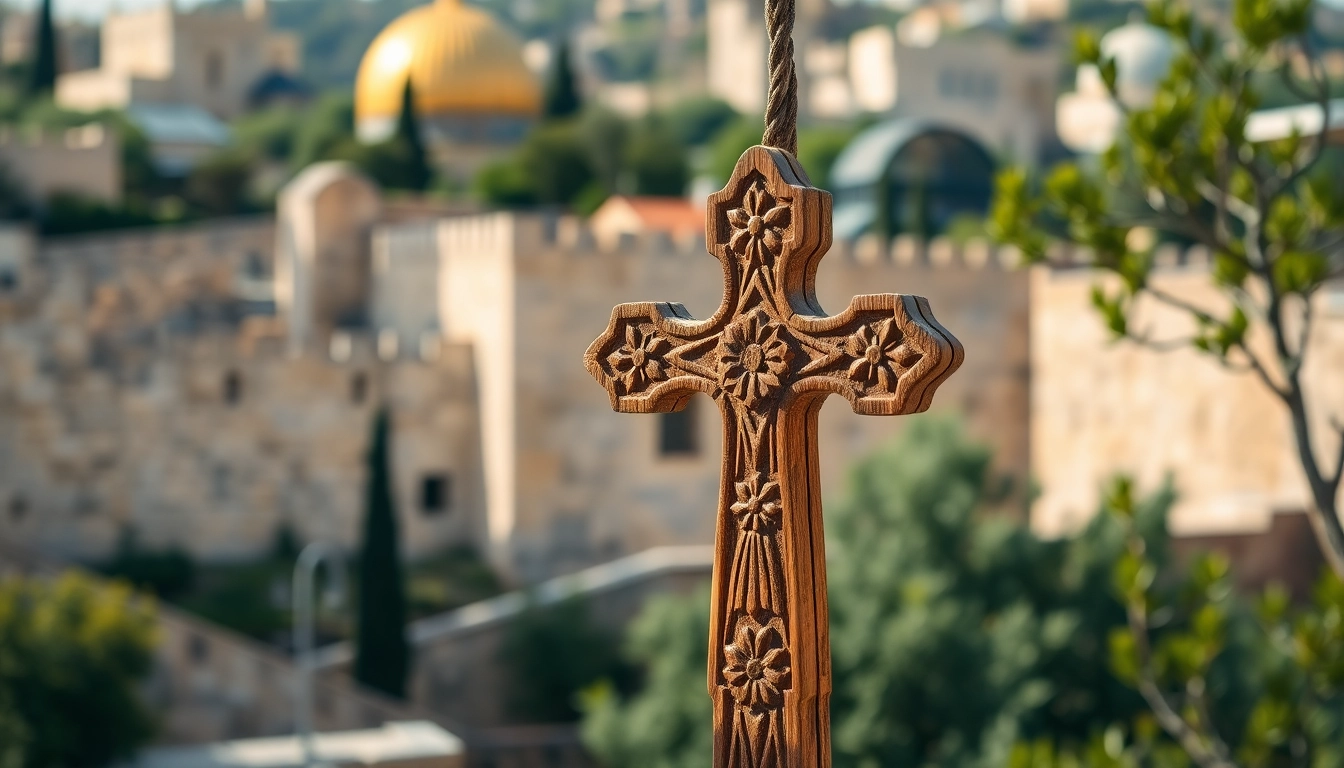Introduction to Jerusalem Crosses
The Jerusalem crosses hold profound significance within Christian tradition and culture. This unique cross design, often referred to as the “five-fold Cross” or “Crusader’s cross,” represents a rich tapestry of historical and spiritual meanings that resonate with believers around the world. In this article, we will explore the intricacies of Jerusalem crosses, delving into their historical origins, designs, spiritual significance, cultural impacts, and practical considerations for those looking to purchase these meaningful symbols.
What are Jerusalem crosses?
The Jerusalem cross is a heraldic cross, characterized by a large cross potent at the center, surrounded by four smaller Greek crosses in each quadrant. This design is not only aesthetically striking but is also imbued with deep symbolic meaning. Each element of the Jerusalem cross carries significance: the large central cross represents Jesus Christ, while the four smaller crosses symbolize the Four Evangelists—Matthew, Mark, Luke, and John—who were instrumental in spreading the Gospel. Additionally, these smaller crosses can also be interpreted to signify the four corners of the earth, addressing the mission of the Church to reach every corner of the globe with the message of Christ.
Historical origins of Jerusalem crosses
The roots of the Jerusalem cross can be traced back to the early days of Christianity, particularly during the era of the Crusades in the 11th and 12th centuries. It was during this time that the cross gained prominence as a symbol of the Kingdom of Jerusalem, established after the First Crusade in 1099. The cross was initially used as a military insignia by the Crusaders, serving both as a rallying point and a symbol of faith. It quickly became synonymous with the Christian community in the Holy Land and has evolved through the ages, maintaining its relevance and meaning within Christian iconography.
Symbolism associated with Jerusalem crosses
The symbolism of the Jerusalem cross is multifaceted. Primarily, it serves as a reminder of Christ’s passion and sacrifice, signifying the centrality of Christ to the Christian faith. The four small crosses surrounding the main cross are often interpreted in several ways:
- The Four Evangelists: Each of the smaller crosses represents one of the Gospel writers, emphasizing the importance of the teachings of Christ.
- The Spread of the Gospel: The smaller crosses signify the mission of the Church to spread the message of salvation throughout the world.
- Unity and Peace: The overall design of the cross symbolizes the unity of believers in Christ, calling for peace and understanding across different cultures and faiths.
The Design and Features of Jerusalem Crosses
Materials used in Jerusalem crosses
Jerusalem crosses can be crafted from a variety of materials, each enhancing the beauty and unique character of the piece. Common materials include:
- Wood: Many Jerusalem crosses are made from olive wood, sourced from the groves of the Holy Land. This choice of wood connects the symbol directly to the land where Christianity originated.
- Metal: Gold, silver, and bronze are often used for more ornate designs, adding an element of luxury and durability. These materials also signify the divinity and glory associated with Christ.
- Stone: In certain artistic interpretations, Jerusalem crosses may also be integrated with precious or semi-precious stones, further embellishing their significance.
Common styles and variations of Jerusalem crosses
Jerusalem crosses come in various styles and variations, catering to different tastes and preferences. Notable styles include:
- Traditional Cross: The classic design features a prominent central cross with four smaller crosses, commonly seen in churches and religious art.
- Modern Interpretations: Contemporary artists often reimagine the Jerusalem cross, infusing it with innovative designs and artistic techniques, while still preserving the fundamental symbolism.
- Customized Crosses: Many artisans offer personalized versions, allowing individuals to incorporate personal elements, such as initials or significant dates, making the cross a truly unique piece.
Personalized designs and their meanings
The personalization of Jerusalem crosses has become increasingly popular, as it allows individuals to express their faith in deeply personal ways. Personalized crosses can include:
- Engravings: Names, dates, or special quotes can be engraved onto the cross, creating a meaningful keepsake.
- Color Choices: Different color schemes may hold specific significance or reflect personal tastes, further enhancing the object’s meaning.
- Incorporation of Additional Symbols: Beyond the standard cross design, some choose to integrate symbols that are significant to their personal faith journey.
Spiritual Significance of Jerusalem Crosses
Jerusalem crosses in Christian faith
In Christian faith, the Jerusalem cross serves as a powerful emblem of devotion, sacrifice, and hope. It represents the commitment of believers to spread the teachings of Christ, reminding them of their spiritual responsibilities. The cross’s presence in homes, churches, and personal items serves as a constant reminder of one’s faith and connection to Christ.
Use of Jerusalem crosses in religious practices
Jerusalem crosses play a significant role in various religious practices, including baptism, confirmation, and marriage ceremonies. As a symbol of faith, it often adorns church altars, liturgical vestments, and personal devotional items. Many Christians wear Jerusalem crosses as pendants or pins, using them as a means of proclaiming their faith and serving as a conversation starter about their beliefs.
Jerusalem crosses as symbols of peace and unity
The overarching message of Jerusalem crosses extends beyond individual faith; it embodies a call for peace and unity among diverse Christian communities. Given its historical roots in the Crusades, where the cross initially represented wartime struggles, today it symbolizes reconciliation and understanding. The cross encourages believers to foster goodwill and collaborative efforts among different denominations and cultures, highlighting the fundamental Christian tenet of love.
Cultural Impact of Jerusalem Crosses
Jerusalem crosses in art and literature
The Jerusalem cross has inspired countless works of art and literature throughout history. Artists have depicted the cross in paintings, sculptures, and stained-glass windows, each rendition bringing forth unique interpretations of its significance. Literature, from medieval texts to contemporary novels, often references the Jerusalem cross as a powerful symbol of faith and devotion, emphasizing its lasting impact on culture.
Modern interpretations of Jerusalem crosses
In recent years, artists and designers have embraced modern interpretations of Jerusalem crosses, creating a fusion of traditional symbolism with contemporary styles. These interpretations often reflect current societal themes such as inclusiveness, social justice, and interfaith dialogue. Through innovative designs, Jerusalem crosses continue to be relevant, appealing to younger generations while retaining their sacred meanings.
Jerusalem crosses as cultural heritage
The Jerusalem cross is not only a religious symbol but also a part of the cultural heritage of Jerusalem and its surrounding areas. The continued production and use of these crosses highlight the intersection of faith, art, and community. Craftsmen in Jerusalem creatively incorporate local traditions, materials, and techniques, ensuring that the legacy of the Jerusalem cross is preserved and celebrated by future generations.
Purchasing Jerusalem Crosses: Tips and Considerations
Where to buy authentic Jerusalem crosses
For those interested in purchasing Jerusalem crosses, authenticity is key. When looking to acquire a piece, consider sources such as local artisans, religious shops in Jerusalem, or reputable online retailers that specialize in Christian artifacts. Ensuring the provenance of the piece will enrich its value, both spiritually and collectably.
Factors to consider when choosing Jerusalem crosses
When choosing a Jerusalem cross, several factors should be taken into account:
- Personal Significance: Consider the spiritual or personal meaning you wish to embody with the cross. This could influence material choice, size, or design.
- Craftsmanship: Examine the quality of craftsmanship and the details of the design. A well-made cross not only lasts longer but also embodies the artistry of its creator.
- Intended Use: Determine how you intend to use the cross. Whether as a decorative piece, a wearable item, or a ceremonial artifact, the choice can influence design decisions.
Caring for and displaying Jerusalem crosses
To maintain the beauty and significance of a Jerusalem cross, proper care is essential. Here are some tips for caring for and displaying your cross:
- Regular Cleaning: Depending on the material, clean the cross gently to preserve its finish. Olive wood, for example, may require occasional oiling to prevent drying.
- Safe Display: If displaying the cross, choose a location where it is protected from excessive sunlight, humidity, and temperature fluctuations that could cause damage.
- Personal Rituals: Some choose to incorporate their Jerusalem cross into personal rituals or devotional practices, further strengthening their connection to the symbol.



